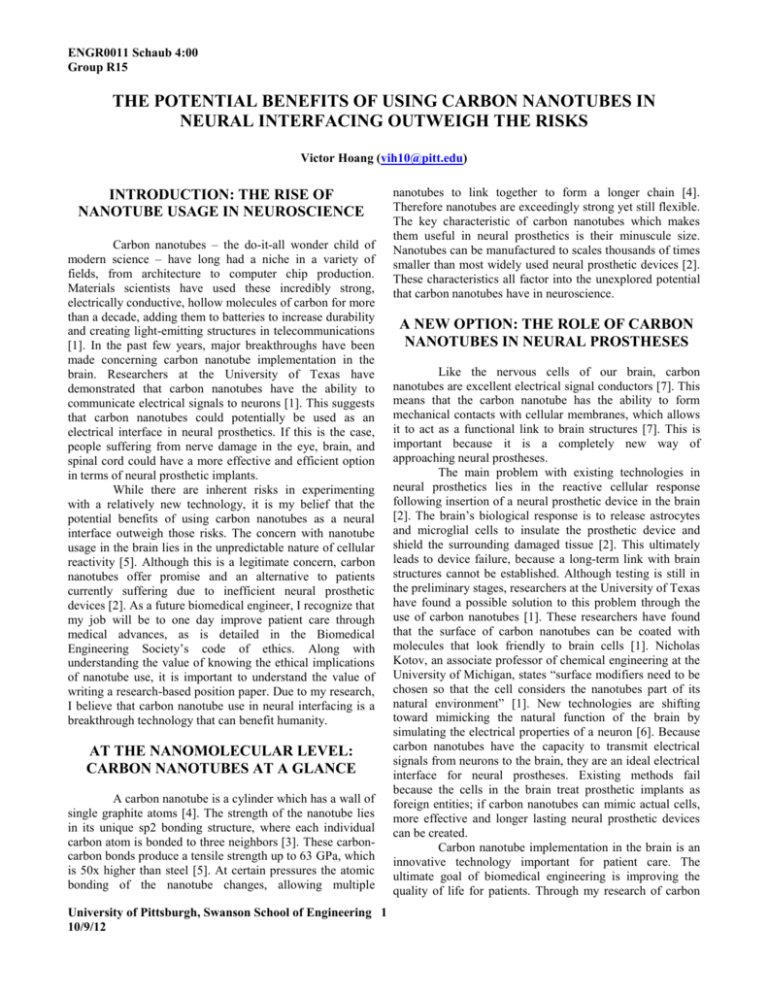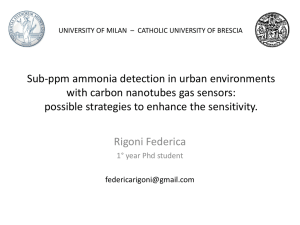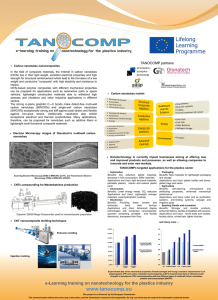Writing Assignment 3 - University of Pittsburgh
advertisement

ENGR0011 Schaub 4:00 Group R15 THE POTENTIAL BENEFITS OF USING CARBON NANOTUBES IN NEURAL INTERFACING OUTWEIGH THE RISKS Victor Hoang (vih10@pitt.edu) INTRODUCTION: THE RISE OF NANOTUBE USAGE IN NEUROSCIENCE Carbon nanotubes – the do-it-all wonder child of modern science – have long had a niche in a variety of fields, from architecture to computer chip production. Materials scientists have used these incredibly strong, electrically conductive, hollow molecules of carbon for more than a decade, adding them to batteries to increase durability and creating light-emitting structures in telecommunications [1]. In the past few years, major breakthroughs have been made concerning carbon nanotube implementation in the brain. Researchers at the University of Texas have demonstrated that carbon nanotubes have the ability to communicate electrical signals to neurons [1]. This suggests that carbon nanotubes could potentially be used as an electrical interface in neural prosthetics. If this is the case, people suffering from nerve damage in the eye, brain, and spinal cord could have a more effective and efficient option in terms of neural prosthetic implants. While there are inherent risks in experimenting with a relatively new technology, it is my belief that the potential benefits of using carbon nanotubes as a neural interface outweigh those risks. The concern with nanotube usage in the brain lies in the unpredictable nature of cellular reactivity [5]. Although this is a legitimate concern, carbon nanotubes offer promise and an alternative to patients currently suffering due to inefficient neural prosthetic devices [2]. As a future biomedical engineer, I recognize that my job will be to one day improve patient care through medical advances, as is detailed in the Biomedical Engineering Society’s code of ethics. Along with understanding the value of knowing the ethical implications of nanotube use, it is important to understand the value of writing a research-based position paper. Due to my research, I believe that carbon nanotube use in neural interfacing is a breakthrough technology that can benefit humanity. AT THE NANOMOLECULAR LEVEL: CARBON NANOTUBES AT A GLANCE A carbon nanotube is a cylinder which has a wall of single graphite atoms [4]. The strength of the nanotube lies in its unique sp2 bonding structure, where each individual carbon atom is bonded to three neighbors [3]. These carboncarbon bonds produce a tensile strength up to 63 GPa, which is 50x higher than steel [5]. At certain pressures the atomic bonding of the nanotube changes, allowing multiple University of Pittsburgh, Swanson School of Engineering 1 10/9/12 nanotubes to link together to form a longer chain [4]. Therefore nanotubes are exceedingly strong yet still flexible. The key characteristic of carbon nanotubes which makes them useful in neural prosthetics is their minuscule size. Nanotubes can be manufactured to scales thousands of times smaller than most widely used neural prosthetic devices [2]. These characteristics all factor into the unexplored potential that carbon nanotubes have in neuroscience. A NEW OPTION: THE ROLE OF CARBON NANOTUBES IN NEURAL PROSTHESES Like the nervous cells of our brain, carbon nanotubes are excellent electrical signal conductors [7]. This means that the carbon nanotube has the ability to form mechanical contacts with cellular membranes, which allows it to act as a functional link to brain structures [7]. This is important because it is a completely new way of approaching neural prostheses. The main problem with existing technologies in neural prosthetics lies in the reactive cellular response following insertion of a neural prosthetic device in the brain [2]. The brain’s biological response is to release astrocytes and microglial cells to insulate the prosthetic device and shield the surrounding damaged tissue [2]. This ultimately leads to device failure, because a long-term link with brain structures cannot be established. Although testing is still in the preliminary stages, researchers at the University of Texas have found a possible solution to this problem through the use of carbon nanotubes [1]. These researchers have found that the surface of carbon nanotubes can be coated with molecules that look friendly to brain cells [1]. Nicholas Kotov, an associate professor of chemical engineering at the University of Michigan, states “surface modifiers need to be chosen so that the cell considers the nanotubes part of its natural environment” [1]. New technologies are shifting toward mimicking the natural function of the brain by simulating the electrical properties of a neuron [6]. Because carbon nanotubes have the capacity to transmit electrical signals from neurons to the brain, they are an ideal electrical interface for neural prostheses. Existing methods fail because the cells in the brain treat prosthetic implants as foreign entities; if carbon nanotubes can mimic actual cells, more effective and longer lasting neural prosthetic devices can be created. Carbon nanotube implementation in the brain is an innovative technology important for patient care. The ultimate goal of biomedical engineering is improving the quality of life for patients. Through my research of carbon Victor Hoang nanotube usage in neural prostheses, I have concluded that the existing methods of neural prosthetic device implementation are inefficient. There is no sense in continuing the use of silicon devices, metal plating, or surface-sensing electrodes – they are simply not effective over a long period of time due to their reactivity with cells in the brain. If my goal as a biomedical engineer is to improve the experience of patients, I would want to create a neural prosthetic device that functions as naturally as possible, acting like a cluster of nerves. If there is even the slightest possibility that that can be achieved through the use of carbon nanotubes then I would commit to understanding and using the new technology as soon as possible. At the same time it would be irresponsible of me to ignore the potential risks that are associated with carbon nanotubes. Understanding the problems with a technology is just as important as understanding the technology itself. FINAL CONCERNS: ETHICAL IMPLICATIONS OF NANOTUBE USE As exciting as nanotube technology is, and as tempting as it may be to push the boundaries of this medical advancement, it is important to not lose sight of the code of ethics that binds all professional engineers. As the first fundamental canon of the National Society of Professional Engineers’ Code of Ethics states, “Engineers shall hold paramount the safety, health, and welfare of the public” [9]. Carbon nanotube use in neural interfacing is an incredibly delicate process that requires implementation of an electrode into the brain. There is no room for error in such a procedure, as the lives of patients are at stake. A faulty neural prosthetic device has an immediate and tangible negative effect on the health of patients, which violates this canon. Only through rigorous testing, data collection, and device modification can biomedical engineers ensure that carbon nanotube integration in neural prostheses will have no negative effects on patients. In terms of advancement in carbon nanotube research, the Biomedical Engineering Society’s code of ethics states that “biomedical engineers involved in health care activities shall consider the broader consequences of their work in regard to cost, availability, and delivery of health care” [10]. Biomedical engineers should focus their research on aspects of nanotube usage that can improve the welfare of patients. The problem with research in a new technology is investing resources into a variety of projects simply for the sake of obtaining information. This is inefficient because valuable time and money is wasted on projects that make no difference in the healthcare of patients. Focusing the bulk of nanotube research on projects that can benefit patient care will result in the development of more research projects that can potentially improve healthcare. As a future biomedical engineer, I understand the value of abiding by a code of ethics. It is critical to understand that the engineering profession is a profession that is dedicated to others. Only through the application of an ethical code that is based on impartiality and integrity can the best methods for improving patient care be utilized. UNCERTAINTY IN NANOTECHNOLOGY: RISKS OF NANOTUBE USAGE The problem with carbon nanotube use is the same problem faced with any relatively new technology – the scarce availability of experimental data. Simple physics states that as a particle shrinks, the ratio of its surface area to its mass rises [5]. Therefore a nanoparticle has a comparatively larger surface area which can lead to greater reactivity. The concern that scientists have with inserting carbon nanotubes into the brain is the unpredictable nature of cellular reactions [1]. For example, a research experiment headed by Chiu-Wing Lam at NASA’s Johnson Space Center found that in the lungs of mice, carbon nanotubes caused lesions that progressively worsened over time [5]. Another example lies in the field of bioimaging, where nanoparticles known as “quantum dots” could potentially be used to detect tumors [5]. However, the quantum dots are typically made up of cadmium selenide, which can be toxic in bulk quantities [5]. These examples illustrate the problem with nanotube usage. There is a lack of reliable data, which makes it difficult to discern whether an experimental result is the norm or a fluke. Regulatory agencies suffer from the same problem. The National Institute for Occupational Safety and Health acknowledges that “minimal information” is available on the health risks associated with nanomaterials contact [5]. These factors combine to create an atmosphere of uncertainty regarding nanotube usage in neural interfacing. The potential benefits are clear, but the data is lagging behind the technology. While the concerns with nanotube usage are legitimate, I believe that it is necessary to continue advanced research in this technology. The potential benefits of carbon nanotube usage in neuroscience could restore damaged nerves and improve neural prosthetics. Even if it takes years to understand the negative consequences, there is no doubt that carbon nanotube technology can improve human lives. REFLECTION: EDUCATIONAL VALUE OF A RESEARCH-BASED POSITION PAPER Research-based position papers have value in any freshman engineering curriculum at any engineering school in the country because students have the opportunity to research topics that genuinely interest them. In a study done at Vanderbilt University, Dr. Paul King found that research projects in the freshman bioengineering curriculum led to “increased retention and interest on the part of the students” [11]. Interested, motivated students are more likely to 2 Victor Hoang immerse themselves into researching and developing their own stance on a topic. My personal experience with this research-based position paper was very positive. I chose to research the role of carbon nanotubes in neural interfacing because I had read articles on the topic and found it to be interesting. After researching the topic, I understood the potential benefits of the technology and concluded that current neural prostheses were ineffective and inefficient. Because of my genuine interest, I reached out to a graduate professor here at the university, Dr. Tracy Cui, who is researching the exact same topic in her lab. After meeting with her one-on-one and discussing the details of my position paper, she offered me a research position in the university’s neural tissue engineering lab. Because of my position paper, I went from reading online articles about experiments involving carbon nanotubes to actually encapsulating carbon nanotubes onto gold-sputtered monomers myself in a state-of-the-art lab. The position paper sparked my interest and led me to seek out an opportunity where I could apply my knowledge. Discussing the ethics of nanotube usage and learning about the professional engineering code of ethics is valuable knowledge as well. Understanding the guidelines and ideals for my eventual profession and how they apply to my research topics gives me the opportunity to better appreciate the engineering profession. hopes that creating a synthetic brain may one day be possible [8]. These innovative medical breakthroughs are an example of the type of work that can be accomplished by well-educated engineers. Producing motivated engineers that research topics that genuinely interest them leads to these types of advances. There are endless possibilities regarding carbon nanotube usage in neuroscience. The potential to benefit millions of lives is clear, and I believe that the only limiting factor is the creativity of the human mind, not the lack of experimental data. As long as the ethical implications of nanotube technology are understood and the code of ethics is followed, there is little reason to stop advancing nanotube usage. Integrating carbon nanotubes into neural prostheses could repair damaged optic nerves and damaged cochlear nerves. Spinal cord paralysis patients could resume normal lives through nerve repairs. All of this can potentially be achieved through nanotube technology and that is why I believe that the potential benefits of using carbon nanotubes in neural interfacing outweigh the risks. The only question I have is – how far can we go? REFERENCES [1] K, Bourzac. (2006). “This Is Your Brain on Nanontubes.” Technology Review. (Online Article). http://www.technologyreview.com/news/405853/this-is-youbrain-on-nanotubes/ [2] N, Tokas. (2010). “Carbon Nanotube-based Neural Prosthetics – Where Smaller is Better.” Nanotech Now. (Online Article). http://www.nanotechnow.com/columns/?article=460 [3] P, Harris. (2010). “Carbon nanotube science and technology.” The University of Reading Personal Web Pages. (Online Article). http://www.personal.reading.ac.uk/~scsharip/tubes.htm#Hist ory [4] D, Memetic. (2010). “Nanotubes.” Tech FAQ. (Online Article). http://www.tech-faq.com/nanotubes.html [5] P, Ross. (2006). “Tiny Toxins?” Technology Review. (Online Article). http://www.technologyreview.com/featuredstory/405743/tiny-toxins/ [6] J, Laskaris. (2011). “An Emerging Tool in Neuroscience.” MD Buyline. (Online Article). http://www.mdbuyline.com/an-emerging-tool-inneuroscience [7] M, Berger. (2012). “Carbon nanotube rope stimulates neural stem cells.” Nano Werk. (Online Article). http://www.nanowerk.com/spotlight/spotid=26029.php [8] E, Mankin. (2011). “Functioning Synapse Created Using Carbon Nanotubes.” Neuroscience News. (Online Article). http://neurosciencenews.com/synapse-using-carbonnanotubes-synthetic-brain/ CONCLUSION: THE FUTURE OF CARBON NANOTUBE USAGE More than 5 million Americans live with disabilities resulting from a traumatic brain injury [2]. Neurodegeneration in the brain can lead to severe motor conditions from loss of limb control to complete paralysis [2]. Nerve damage correction has been attempted for decades through the implementation of neural prosthetic devices. Recent technological advances in the field have shown that carbon nanotubes can be used in neural interfacing to create more efficient and longer lasting prosthetic devices. The main problem with the nanotube technology is the lack of experimental data available. As a future biomedical engineer, I believe that it is crucial to utilize this technology to improve patient care. While it is important to understand the risks involved with nanotube implementation, it is equally important to push the boundaries of this exciting breakthrough. Already scientists have found that carbon nanotubes can be used as a scaffold to physically repair damaged nerves [6]. Thomas Webster, an associate professor of materials science and biomedical engineering at Brown University, has demonstrated that carbon nanotubes help stem cells stay in place after they are injected into damaged brain cells [1]. Engineering researchers at the University of Southern California have built a carbon nanotube synapse circuit which can reproduce the function of a neuron, raising 3 Victor Hoang [9] (2012). “NSPE Code of Ethics for Engineers.” National Society of Professional Engineers. (Online Article). http://www.nspe.org/Ethics/CodeofEthics/index.html [10] (2012). “Biomedical Engineering Society Code of Ethics.” Biomedical Engineering Society. (Online Article). http://www.bmes.org/aws/BMES/pt/sp/ethics [11] P, King. (2002). “Freshman Biomedical Engineering Design Projects: What Can Be Done?” American Society for Engineering Education. (Online Article). http://www.vanth.org/docs/005_2002.pdf ACKNOWLEDGEMENTS I would like to thank the University of Pittsburgh for having no classes on Monday, October 8th so that I could write my paper. I would also like to thank Cheese for sharing his Doritos with me. Finally, I would like to shout out my roommate Chris for editing my paper. 4






